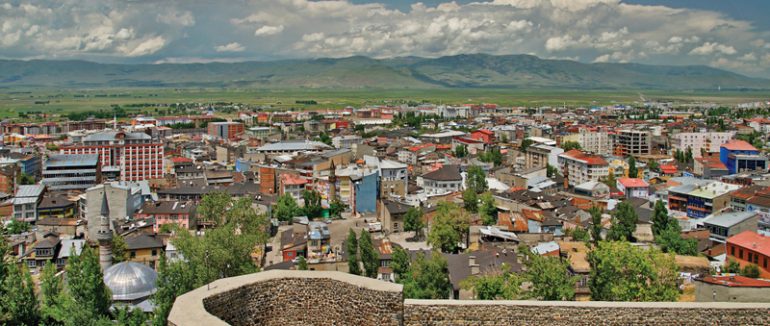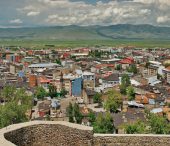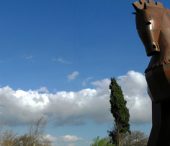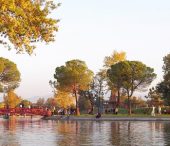Erzurum, see also its former and other names) is a city in eastern Anatolia, Turkey. The name "Erzurum" derives from "Arz-u Rum" (literally The Land of the Romans in Persian).
Erzurum has a population of 361,235 (2000 census). It is the capital of Erzurum Province, the largest province in Turkey's Eastern Anatolia Region. The city is situated 1757 meters (5766 feet) above sea level and has an extreme continental climate with an average January temperature of −11 °C (12.2 °F). Temperatures often drop below −30 °C (−22.0 °F) in the winter, with heavy snowfall.
Erzurum, known as "The Rock" in NATO code, has served as NATO's southeasternmost air force post during the Cold War.
The city uses the double-headed Anatolian Seljuk Eagle as its coat-of-arms, a motif based on the double-headed Byzantine Eagle that was a common symbol throughout Anatolia and the Balkans in the medieval period.
History
Erzurum existed since the ancient times as Karin and at various times belonged to ancient Armenia, Persian, Roman, Seljuk Turks, and Ottoman Empires.
The town was known in Byzantine times as Theodosiopolis, acquiring its present name only after its final Muslim conquest following the battle of Manzikert.
Saltuklus were an Anatolian Turkish Beylik centered in Erzurum, who ruled between 1071 to 1202. Melike Mama Hatun, sister of Nâsırüddin Muhammed, was the ruler between 1191 and 1200.
The city was captured by Russia in 1829, but given back to the Ottoman Empire under the Treaty of Adrianople (Edirne). During the Crimean war Russian forces approached Erzurum, but did not attack it because of insufficient forces and the continuing Russian siege of Kars. The city was attacked and, after overcoming strong resistance, captured by a Russian army in the Russo-Turkish War of 1877-78, but was returned to the Ottoman Empire under the Treaty of San Stefano.
There were massacres of the city's Armenian citizens during the Hamidian massacres (1894-1896). It was also a major extermination and deportation center during the Armenian Genocide of 1915. The deportation route for the Armenians of Erzurum and neighbouring areas in eastern Anatolia went through the city of Harput.
The city was the location of one of the key battles in the Caucasus Campaign of World War I between the armies of the Ottoman and Russian Empires which resulted in capture of Erzurum by Russian forces under command of Grand Duke Nicholas and Nikolai Nikolaevich Yudenich on February 16, 1916. It was returned to the Ottomans with the Treaty of Brest-Litovsk in 1918.
Mustafa Kemal Atatürk, one of the founders of the modern Turkish Republic, resigned from the Ottoman Army in Erzurum, and was declared the "Honorary Native" and the freeman of the city, which issued him his first citizenship registration and certificate (Nüfus Cuzdanı) of the new Turkish Republic. The Erzurum Congress of 1919 was one of the starting points of the Turkish War of Independence.
Economy
The largest economy, in recent years, has been the university. Atatürk University is one of the largest universities in Turkey, having more than forty-thousand students. Tourism, also, provides a large proportion of the province's income.
Erzurum is notable for the small-scale production of objects crafted from Oltu stone: most are sold as souvenirs and include prayer beads, bracelets, necklaces, brooches, earrings and hairclips.
Tourism
Little of medieval Erzurum survives beyond scattered individual buildings such as the citadel fortress, and the Çifte Minareli Medrese.
Six kilometres to the south of the center of Erzurum is an important skiing center on the Palandöken Mountain range. There are several ski runs; the south ski run is 8 km long, the north ski run is intended for advanced skiers. The highest point of Mt. Palandöken, great Ejder at 3188m, can be reached to an altitude of 3100 metres by a chair lift. The International University Sports Federation (FISU) World Winter Games, 2011 Winter Universiade, will be held in Erzurum.
Cuisine
One specialty of Erzurum's cuisine is Ciğ Kebab. Although this kebab variety is of recent introduction outside its native region, it is rapidly attaining wide-spread popularity around Turkey.
Besides, Kadayif Dolmasi is an exquisite sugary. There is walnut in Kadayif Dolmasi.










